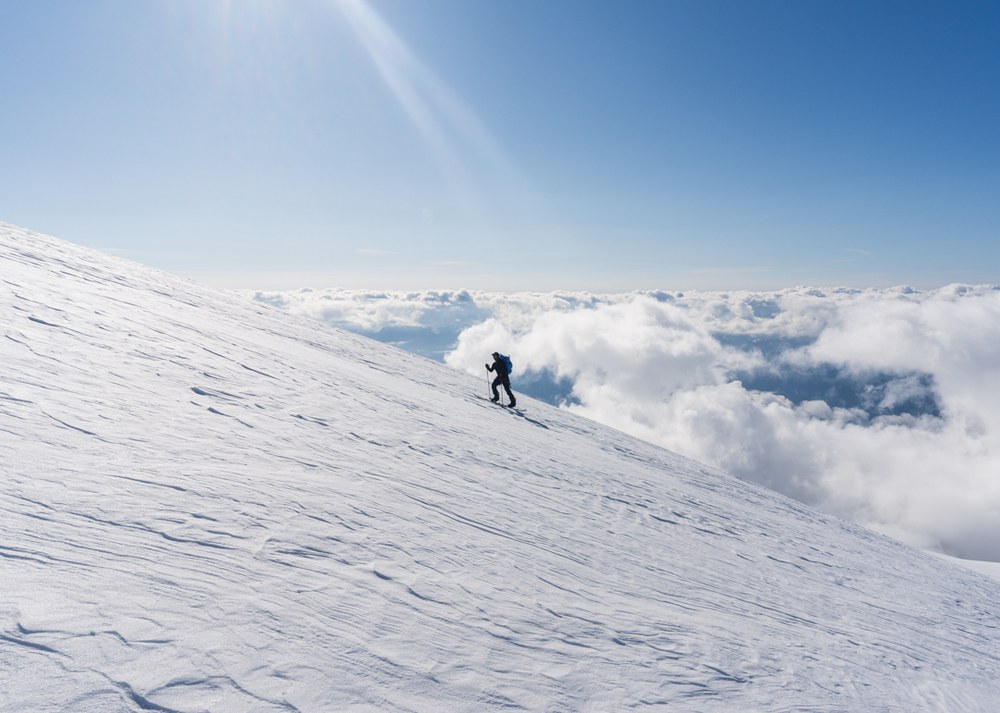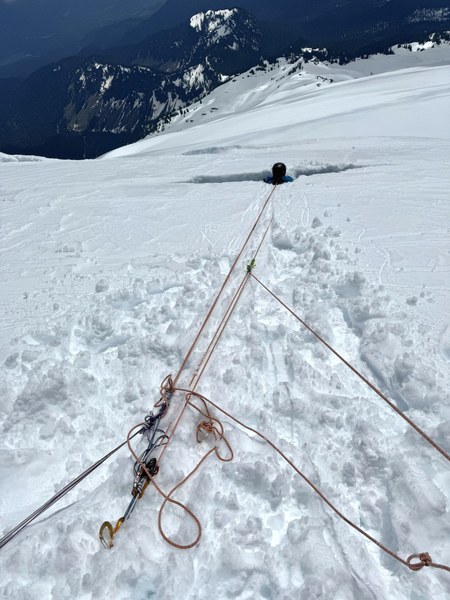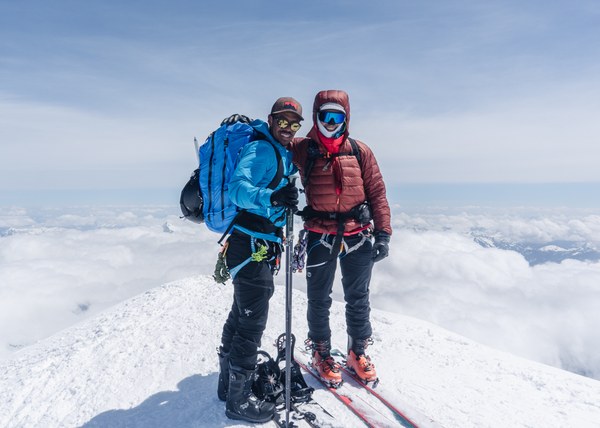
The purpose of this report is to provide transparency regarding the risks of glacier travel and influence motivation for technical competency in glaciated terrain. Below is a detailed report on a crevasse fall and rescue that occurred on the Squak glacier, Kulshan (Mount Baker) on May 23rd, 2025. No injuries were sustained.
My name is Manny Pacheco, a passionate mountain recreationalist from Bellingham/Seattle and a ski/rock mentor for The Mountaineers, Climbers of Color and BOEALPS. On May 23rd, 2025, my long-time friend Daton Nestlebush and I set out from Park Butte trailhead at 3am with the goal of skiing Kulshan via the Squak glacier route. During the previous week, our team thinned from four members down to just Daton and I. Daton is a passionate mountain biker and snowboarder but had limited experience in high alpine terrain. This was his first time on a glacier attempting to summit a cascade volcano. I opted to consciously take the risk of travelling with an inexperienced climber in glaciated terrain as this is a route I was familiar with and felt confident to play guide for the day. At 5:15am we arrived at the toe of the Squak glacier. We put on our harnesses, made a couple gear checks and I quickly taught Daton how to bury a picket and fix a rope to it. The thought here was if I were to fall into a crevasse, he’d have the bare skill that allows me to self-rescue by ascending the rope; this assumes I’m conscious and able to pull off a self-rescue – a risk I intentionally took.
Fast forward, we worked our way up the standard Squak glacier and reached the summit by noon. I’d dreamt of skiing this mountain with my high-school/college friends for years and I’ve slowly been ticking off this goal. Daton, albeit having bonked his way up the Roman headwall, was psyched to look down on Shuksan, the North Cascades, Bellingham Bay and the low marine layer that had engulfed the surrounding peaks. This was my seventh summit of Kulshan and was stoked to share it with Daton. We transitioned and made our way down the Roman headwall and back onto the Squak glacier. I took lead of the route-finding role both up and down. We skied ~500 foot pitches and took turns watching each other. At 1:15pm I continued to ski, finding untracked corn between previous tracks to both my right and left. I was slightly skier’s left of our up track and at 7950 feet I stopped abruptly as I saw large crevasses ~100 feet in front of me. The tracks I’d been following for the last pitch began to traverse right, back to our ascent track. I turned around and pointed to my right and radioed Daton to traverse skier’s right, keeping a high line. He passed me and we both started a ~300 foot descending traverse to bypass the convex terrain that produced crevasses and seracs, visible from our ascent. There were continuous traversing tracks downhill of us.
As I followed Daton, who was on a snowboard, traversing slow and high to regain our position, he suddenly collapsed a thin snow bridge and dropped; exposing a large crevasse below. His reaction was to raise his arms into a “T” shape which caught him between the uphill and downhill crevasse lips. His snowboard tip was slightly caught on a small ice chunk attached to the crevasse wall ~4 feet below the surface. To me, only his arms and head were visible above the surface. “Oh f*ck” I whispered to myself. I immediately redirected my momentum uphill and crossed another small crevasse ~10 feet uphill of Daton, this detail becomes important later. I stationed myself ~20 feet directly uphill of Daton, used the back of my pole to check for crevasses within a 5 foot radius and began the rescue process. I turned to Daton, told him to not move and that I’d throw him a rope in 60 seconds. “You’re going to be okay”, I must’ve said this five times within the first few minutes. My immediate goal was to fix Daton to an anchor as soon as possible. He was holding himself up primarily by his arms on the crevasse lips as the rest of his body levitated above a widening ~60 foot deep crevasse. “Can you make that 45 seconds?” Daton said surprisingly calmly. I knew at that moment that seconds were crucial, his arms were quickly fatiguing and position was precarious to say the least. I made a trench with my ice axe adze, buried a picket in a deadman position, stomped on the picket ~1 foot deep and backfilled the trench. The late spring dense snow was perfect for a picket burial. I attached a figure eight on a bite to the picket’s cable and another figure eight on a bite ~20 feet from the anchor. I threw this to Daton and he caught the rope. A couple options I had thought through before deciding on this option was to throw a “Drop C” (a carabiner on a bite) instead of a figure eight. The reason my split-second decision went to figure eight was the urgency to have him fixed on both sides and the ability for Daton to grab onto the large figure eight loop with his hand; a feature that he later said was critical. A Drop C would’ve required the other end of the rope to be fixed – one less step and a simpler fixed option saved me a few seconds. Although I knew time was ticking, I was methodical with every step. Slow is smooth and smooth is fast.
 This picture was taken during a stable final moment of the rescue while we were discussing options on how Daton would mantle past the lip. This report was posted with his permission.
This picture was taken during a stable final moment of the rescue while we were discussing options on how Daton would mantle past the lip. This report was posted with his permission.
Daton grabbed the figure eight loop with his right hand. He now had to commit fully into letting go from the uphill lip and attach the figure eight loop onto his pre-rigged locking carabiner on his belay loop. As he committed, I attached myself to the other end of the figure eight on a bite, becoming a secondary piece to the anchor system. The committing move to let go of the lip and attach the fixed rope to his harness resulted in him dropping a couple feet. After what felt like 10 minutes, but likely 30 seconds, he shouted that he had attached the rope to his harness. He was now fully inside the crevasse and fully weighing the system. My initial plan was for Daton to use the fixed line as an aid to pull himself over the lip - this was insufficient once his head dropped below the surface. At this moment, I still shared the load with the picket and decided to bury my ice axe in a deadman and connect a double sling onto the picket cable’s carabiner, making this the master point. I took myself out of the system and reconnected my harness with an extended prusik for my own safety. As I had shared some of the load, the weight transfer from my harness to the master point lowered Daton another few inches to the lowest point; his head was ~5ft under the surface, a total of a ~10-12 foot fall. At this point I yelled to Daton (communication was difficult now that his head was below the surface) that he’s going to be okay, to take a breath and to give me a couple minutes to set up an independent haul system. Daton was airborne and fully weighing the anchor. Looking between his legs, a deep, dark crevasse loomed beneath.
Although this stage of the rescue was less time-sensitive, I was concerned about the “Harness Hang Syndrome”. This is a type of suspension trauma where the victim loses consciousness due to lack of blood circulation from the thin harness squeezing both legs. Time was still of value. I began to rig a 3:1 haul system with the other end of the rope. I threw the end of the rope with a carabiner on a figure eight down to Daton where he clipped it onto his belay loop. A Drop C was not doable due to limited rope length given the fixed line being used to hold his weight. A curveball scenario was thrown at me; there was likely a secondary crevasse between the anchor/haul system and Daton’s crevasse. I had crossed this crevasse between watching Daton drop and getting into the anchor position. I did not want to risk falling into a crevasse and knew that I was unable to “prepare the lip” and set a pole/axe underneath the new load rope to avoid the rope cutting into the crevasse lip. I figured we would problem solve once his head was above the surface once again. I placed a microtraxion (a progress capture device, very useful) on the master point and a prusik on the new load line. Clipped the redirected load line onto my belay loop and told Daton to expect to be raised. After double-checking the system, I started bear crawling uphill until the prusik had to be reset. A 3:1 system with friction meant I was pulling ~100-120 lbs. Bear crawl, reset prusik, rinse, repeat.
Daton’s beautiful face was now above the surface but progress was halted as the haul rope was cutting into the crevasse lip. We took a minute to talk through options. We decided that taking his backpack off would enable him to move more freely. I threw him the original end of the rope with a non-locker to clip onto his pack strap; his backpack was off. I told him to unbuckle one of his boots from his snowboard and leverage the original fixed rope as a hand line with the hope of mantling over the lip. As I had decided I wouldn’t risk approaching the crevasse, I now hoped he could solve this final step. With a combination of his newfound ability to move his feet independently, lack of pack weight and a handline, Daton climbed out of the crevasse and quickly crawled back to the anchor. A huge sigh of relief and weight lifted off our shoulders. Very timely, two skiers approached us just moments after Daton was out as they traversed the same line we’d taken. I pointed and yelled to stay high. We chatted for a couple minutes with them as Daton and I packed the glacier equipment. The rest of the ski off the Squak and into the forest was uneventful. Adrenaline slowly wore off as we continued to chat and process what had happened.
 Daton and Manny on the summit.
Daton and Manny on the summit.
Below are a few notable reflection points:
- Regardless of how “chill” or filled a glacier is, an unlucky pressure point can lead to a nightmare scenario. The snow bridge was intact and only exposed the hidden crevasse after the bridge failed.
- We got lucky that Daton was in front of me and that I had a visual of the fall.
- If I were in front and he fell behind me, I likely would not have noticed immediately, dramatically slowing down reaction time for a rescue.
- We got lucky that Daton was the person that fell due to the discrepancy in glacier rescue experience. If I were to have fallen and become unconscious, we’d likely be relying on the help of other skiers nearby.
- We got lucky that Daton had the reaction he did and was able to hold his position for ~2 minutes while I set up a fixed line to an anchor. Otherwise a ~60 foot fall was the worst case and a more complicated rescue involving a rappel would’ve been necessary if trauma occurred.
- If Daton was solo and if nobody noticed his need for help, he would’ve likely fallen underneath the surface from muscle fatigue where a self-rescue would’ve been the only option for survival. Snow/ice dampens any yelling.
- The process and system I used was not flawless and likely not the optimal choice given the situation. I had to initially act decisively as time was critical. In practice scenarios, your mind and body are ready. In reality, sh*t hits the fan fast. The important aspects of the system (think SERENE) were second nature as trad climbing shares similar systems. Stay methodical; slow is smooth, smooth is fast.
- My tolerance with those who I travel on glaciers has lowered after this incident.
The underlying purpose of this report and story is to be transparent with our raw experience and to encourage those that enjoy recreating in glaciated terrain that travelling on glaciers requires competency in an ability to conduct a worst-case crevasse rescue. Please do your due diligence and take crevasse rescue courses instructed by professionals or recreate with knowledgeable friends who are willing to mentor. If I had not sought mentorship and instruction initially, and most importantly refreshed these skills yearly at the beginning of each season, the outcome of this incident would have been different.
This report was originally published on Turns All Year. It has been republished here with the author's permission.
Add a comment
Log in to add comments.Lucky the snow was firm enough. It appears the lip was not padded. Had the rope seriously entrenched this could have been a big problem.
Hi Gregg, there was a crevasse between myself and the victim so I opted to not risk preparing the lip and stepping into the secondary crevasse. That detail is in the report above :)
Thank you for sharing, Manny! I almost fainted reading your story. This could happen to anyone who skis on glaciers and you handled it very well. People, including myself, choose to accept these risks, suckered in by the great fun that can be had. Guess why the Rainier climbing rangers hate to see people skiing! You also illustrate the special skillsets that are needed for 2-person crevasse rescue, and the greatly increased risk that is taken if traveling in a small party.
 Emmanuel Pacheco
Emmanuel Pacheco